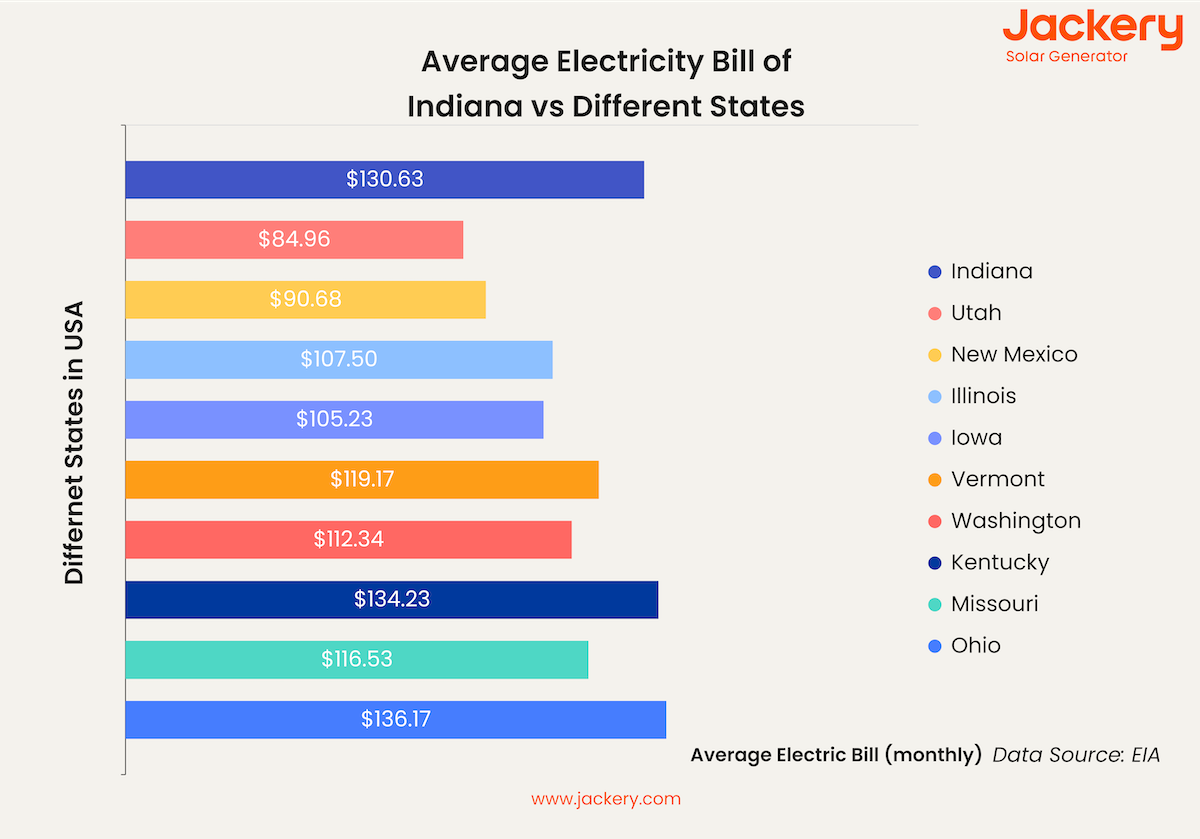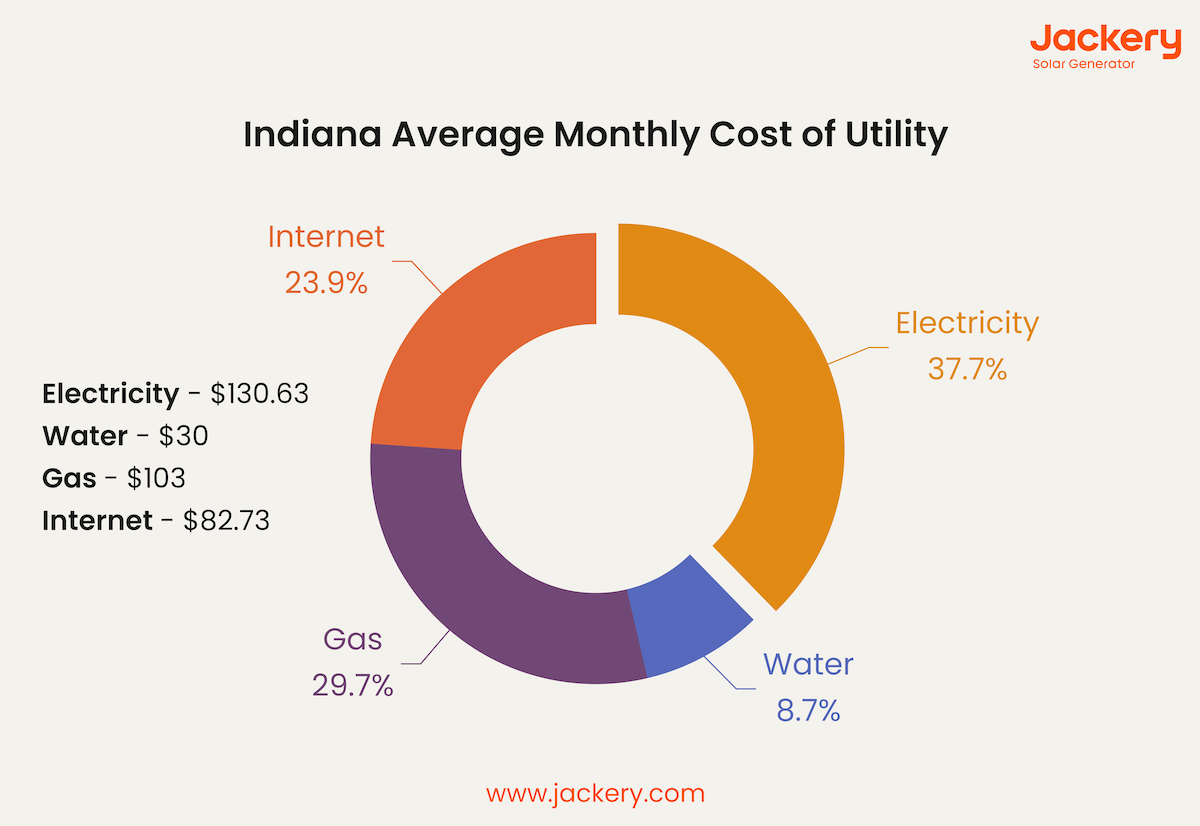With a diverse economy of $352.62 billion, the state of Indiana is famous for having 24 coal power plants that help generate energy. With around 1,340 MW of wind turbines in place, Indiana residents favor renewable resources for electricity. That said, Indiana residents' monthly average electric bill is $141.45.
Jackery Solar Generators have a powerful battery capacity and are best for those looking to reduce their average electric bill in Indiana. The Jackery Solar Generator 3000 Pro and Jackery Solar Generator 2000 Plus are environmentally friendly options that can run up to 99% of household appliances.
What Is The Average Electric Bill In Indiana?
As of June 2024, the average electric price in Indiana is 14.89 ¢/kWh. Based on the average usage of 896 kWh per month, the average electric bill in Indiana is $141.45. The average electric bill in the United States is $147.52, based on a monthly average of 899 kWh and an average electricity rate of 16.41 ¢/kWh.

It suggests that Indiana residents pay around $3.42 more per month than residents of other states. To understand where Indiana stands in terms of average electric bill and overall national ranking, check out the following table comparing Indiana against nine other major states.
|
State |
Avg. Bill |
Avg. Rate |
Monthly Usage |
National Ranking |
|
Indiana |
$141.45 |
14.89 ¢/kWh |
950 kWh |
27 |
|
Utah |
$90.04 |
11.50 ¢/kWh |
783 kWh |
1 |
|
New Mexico |
$95.15 |
14.44 ¢/kWh |
659 kWh |
2 |
|
Illinois |
$116.28 |
16.15 ¢/kWh |
720 kWh |
7 |
|
Iowa |
$131.60 |
14.82 ¢/kWh |
888 kWh |
12 |
|
Vermont |
$124.44 |
21.91 ¢/kWh |
568 kWh |
13 |
|
Washington |
$125.00 |
12.34 ¢/kWh |
1013 kWh |
11 |
|
Kentucky |
$140.79 |
12.87 ¢/kWh |
1094 kWh |
23 |
|
Missouri |
$157.67 |
14.64 ¢/kWh |
1077 kWh |
19 |
|
Ohio |
$139.14 |
15.92 ¢/kWh |
874 kWh |
29 |
Source: EIA
Indiana's average electric bill at $141.45 per month, which places it at 27th nationally, slightly exceeding those of other states mentioned in the table. It is crucial to acknowledge the state's commitment to clean energy. Indiana's Clean Energy Portfolio Standard has set a voluntary goal of achieving 10% clean energy by 2025.

What Are The Electric Rates In Indiana?
Electricity rates denote the cost end-users pay per unit of electricity used, usually measured in cents per kilowatt-hour. These average rates are influenced by multiple factors, such as generation costs, grid maintenance, regulatory policies, and the provider's profit margin.
Indiana Utility Regulatory Provider has deregulated electricity, and there are several investor-owned electricity providers in the state. For instance, AES Indiana provides electricity at a rate of 13.92 ¢/kWh, while Southeastern Indiana offers a rate of 12.96 ¢/kWh. These rates vary depending on the infrastructure cost, supply charges, and other regulations.
Compared to the residential electricity bills, commercial electricity prices in Indiana stand at 12.57 ¢/kWh, while industrial buildings pay around 7.82 ¢/kWh. These rates are slightly higher than the national averages, where commercial electricity costs 13.10 ¢/kWh and industrial electricity is priced at 8.44 ¢/kWh.
What Determines My Monthly Electric Bill In Indiana?
Several factors take part in determining monthly electric bill in Indiana for one person or an entire household, like:
Electric Rates
The electric rates depend on utility operations, which cover infrastructure maintenance, employee salaries, and general business costs.
Fuel Costs
Fuel costs represent the expenditures associated with sourcing coal or natural gas. The Indiana Utility Regulatory Commission and the Indiana Office of Utility Consumer Counselor scrutinize these costs to ensure fair price adjustments.
Purchased Power Costs
These reflect the expenses that are incurred from procuring electricity from the wholesale market to meet the market's demand fluctuations.
Regional Transmission
These costs cover the expenses associated with regional transmission operators. For instance, the Midwest Independent Transmission System Operators are responsible for maintaining the power grid's reliability over large demographic areas.
Taxes
The state tax also determines the average electric bill in Indiana. The 7% sales tax on electric usage contributes to government revenue and influences consumer costs.
How Much Does It Cost To Live In Indiana?
Indiana has one of the country's lowest living costs, ranking it 8th in a list of the lowest to the highest states. The average cost of living in Indiana is $1197.5.
As of April 2024, the monthly cost for a single person is $1197.5, and for a family of four, it is roughly $4202.3. Comparatively, the same family of four would pay $5.795.70 if they lived in NYC, which is 37.95% more than the Indiana residents.
This cost depends on several factors: location, transport mode, utilities and appliances, residents, and lifestyle preferences. Some of the most common utilities in Indiana are:
- Electricity: Indiana's average electric bill is $141.45 per month, and from an estimated living cost of $1197.5, a typical resident in Indiana pays. The electricity bill alone accounts for roughly over 11% of the monthly cost of living.
- Water: The average price of monthly water consumption is generally included in the monthly housing rent. However, it comes to roughly around $30 per month if taken separately.
- Gas: Many households in Indiana use gas to power their stoves for cooking or warm their houses during the winter. On average, gas costs another $103 per month.
- Internet: A monthly internet connection for a 60 Mbps or higher plan would cost $82.73 monthly.

How To Save Money On Electricity Or Utility In Indiana?
Average electricity and other utilities constitute a significant portion of monthly expenses, which exerts a notable impact on overall living costs. However, there are several tips that would help someone save money on average electric or utility bill in Indiana, like:
Routine Maintenance
Regular maintenance of household appliances ensures efficient operations of HVAC systems. One can replace air filters and conduct annual check-ups with reputable repair services.
Upgrade the Appliances
It is highly recommended that the old household appliances be upgraded with new ones that consume less electricity. For instance, one can switch to LED lighting over traditional bulbs, install dimmer switches, or use smart power strips to save electric bills.
Check Standby Power
Check out the electric appliances that consume electricity even when they are put on standby mode. Unplug such appliances and only plug them into the socket when they are needed.
Invest in Renewable
Wind or solar energy would save you a lot of money by reducing the monthly electric bill. The state of Indiana has several policies that help the residents who aim to start using solar energy.
If you have a tight budget but still wish to start utilizing solar energy to charge your household appliances, like refrigerator, television, water heater, air conditioner, etc., you can get Jackery Solar Generators. The Jackery Solar Generators are economical compared to the solar panel installations on the roof. Additionally, the products are small in size, which makes it easier for residents to move them accordingly.
Jackery Solar Generators for Lowering Your Electric Bills
Jackery is a leading manufacturer and seller of solar generators, battery backup devices, and solar panels. The high-capacity batteries of Jackery's solar generators enable it to charge 99% of household appliances.
The Jackery SolarSaga Solar Panels harness sunlight and convert it into DC electricity via monocrystalline silicon solar cells. The Jackery Explorer Portable Power Station's pure sine wave inverter then transforms this stored energy into AC current, charging household appliances. With Jackery Solar Generators, one can significantly lower one's monthly average electric bill in an Indiana apartment.
Jackery Solar Generator 3000 Pro
The Jackery Solar Generator 3000 Pro comes with a robust NMC battery with a capacity of 3024 Wh. This solar generator is ideal for powering 99% of household appliances, such as televisions, coffee makers, refrigerators, etc. The Jackery Solar Generator 3000 Pro can be fully charged in only 3.5 hours when plugged in with 6*Jackery SolarSaga 200W Solar Panels or in 2.4 hours when plugged into an AC adapter.

|
|
Solar Generator 3000 Pro |
|
Capacity |
3024 Wh |
|
Battery Cell |
NMC |
|
Cycle Life |
2000 cycles to 70%+ capacity |
|
Recharging Methods |
Solar Recharging: 3.5 H (6*Jackery SolarSaga 200W Solar Panels) Car Recharging: 35 H Wall Recharging: 2.4 H |
|
Output Ports |
AC Output (x1): 120 V~ 60 Hz 25 A Max AC Output (x3): 120 V~ 60 Hz 20 A Maximum USB-C Output (x2): 100 W Maximum, 5 V⎓3 A, 9 V⎓3 A, 12 V⎓3 A, 15 V⎓3 A, 20 V⎓5 A |
|
Working Hours |
Vacuum Cleaner (1500 W): 1.7 H Rice Cooker (1000 W): 2.5 H Sump Pump (800 W): 3.2 H Mixer Grinder (750 W): 3.4 H Air Purifier (200 W): 12.8 H |
|
Customer Review |
"I was able to run every single appliance in my house without any problem, the 4-door refrigerator, the 85-inch TV, the 4 1 portable air conditioner, electric fans, etc." –- Jocarpo. |
Jackery Solar Generator 2000 Plus
The Jackery Solar Generator 2000 Plus has a LiFePO4 battery with a 2042.8 Wh capacity. This solar generator supports up to 5 additional battery packs that expand its capacity from 2 kWh to 12 kWh. Jackery Battery Pack 2000 Plus can further expand to a 24 kWh (or 24,000 Wh) capacity.

|
|
Solar Generator 2000 Plus |
|
Capacity |
2-24 kWh |
|
Battery Cell |
LiFePO4 |
|
Cycle Life |
4000 cycles to 70%+ capacity |
|
Recharging Methods |
Solar Recharging: 2 H (6*Jackery SolarSaga 200W Solar Panels) Car Recharging: 25 H Wall Recharging: 2 H |
|
Output Ports |
AC Output (×4) 120 V~ 60 Hz, 20 A Maximum AC Output (×1) 120 V~ 60 Hz, 25 A Maximum USB-A Output (x2): Quick Charge 3.0, 18 W Maximum USB-C Output (x2): 100 W Maximum, (5 V, 9 V, 12 V, 15 V, 20 V up to 5 A) |
|
Working Hours |
Coffee Machine (1500 W): 1.1 H Electric Kettle (1500 W): 1.1 H Toaster (1100 W): 1.5 H Air Purifier (200 W): 8.6 H Standard Light Bulb (60 W): 28.9 H |
|
Customer Review |
"Enough power for me for van camping or in a power outage. Hold charge well." — Mo. |
Indiana Average Electric Bill FAQs
What size of solar generator do I need for my house in Indiana?
The size of a solar generator depends upon multiple factors, like size of the apartment, number of residents and appliances in use, etc. For instance, the size of a solar generator for your house in Indiana would differ from a 3-bedroom apartment with five family members.
For instance, if you have a 2-bedroom apartment in Indianapolis and are charging a vacuum cleaner (1500 W), sump pump (800 W), and standard light bulb (60 W) simultaneously with the Jackery Solar Generator 3000 Pro:
Working Hours = Battery Capacity in Wh * 0.85 / Wattage Consumption of All Appliances
Working Hours = 3024 Wh * 0.85/2360 W = 1.08 H.
We have multiplied by 0.85 since there will be some loss of power when charging the appliances.
How can I manage my electric bill in Indiana?
The easiest way to manage your electric bill in Indiana is to properly plan your monthly budget according to your cost of living. Additionally, you can start using energy efficiently by upgrading the appliances and pivoting to solar energy usage.
How much is the average utility bill in Indiana?
The average utility bill in Indiana can be explained from the following table:
|
Utility |
Monthly Avg. Bill |
|
Electricity |
$141.45 |
|
Healthcare |
$707 |
|
Gas |
$103 |
|
Internet |
$82.73 |
|
Water |
$30 |
Why is Indiana Electric so expensive?
Even though there are several coal power plants, the state of Indiana still heavily relies on fossil fields to produce electricity. If a household intends to lower its average electric bill, it is recommended that it invest in renewables, like solar energy.
What is the average cost per kWh in Indiana?
According to EIA, the average electric cost in Indiana is 14.58 ¢/kWh. Meanwhile, the average electric cost in other states depends on multiple factors. For instance, Utah's average electric cost is 10.85 ¢/kWh, New Mexico at 13.76 ¢/kWh, Iowa at 11.85 ¢/kWh, Washington at 11.09 ¢/kWh, and Ohio at 15.58 ¢/kWh.
Final Thoughts
With the rise in the cost of living in Indiana, the monthly average electric bill is also going to increase. Several states in the US have seen a sudden rise in their average electric bill in the last decade, and the price is expected to increase in the next five years. If you aim to reduce your monthly average bill and save on other utilities, it is high time to invest in renewable energies. Jackery Solar Generators have great battery capacity, and once they are fully charged, they can charge up to 99% of household appliances. Jackery offers a sustainable model for all those who are finding ways to reduce their average electric bill in Indiana.







































![[Add - on] Jackery Manual Transfer Switch for Explorer 5000 Plus - Jackery](http://www.jackery.com/cdn/shop/files/add-on-jackery-manual-transfer-switch-for-explorer-5000-plus-9017324.png?v=1754016782&width=170)























































































![What Is The Average Electric Bill In Indiana [2024 Updated]](http://www.jackery.com/cdn/shop/articles/what-is-the-average-electric-bill-in-indiana-2024-updated-8746228.jpg?v=1754018045)







Leave a comment